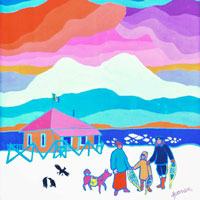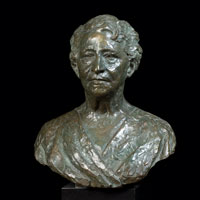May Tea?
In this work by Métis artist David Garneau, a rugged-looking cowboy with a weathered face appears distraught and apprehensive. A speech bubble above him reads, “May Tea?” a farcical play on words that expresses his almost childlike confusion over hearing the word Métis. A single teardrop falls from his left eye as he grasps at his throat. Though no immediate external threat is visible, the character’s concern is palpable. The imagery is striking and commands contemplation from the viewer.
With heavy black outlines and shadowing using cross hatching, the artist skillfully utilizes drawing techniques that call to mind the golden age of comics, an idyllic time when there was a clear animated distinction between good and evil, to open up a dialogue about the place of Métis people in Canadian history as well as bravely exploring his own struggle with identity and “inbetweeness.”
The man’s right hand at the neck is a reference to the execution of Métis leader Louis Riel, and the plight the Métis people faced afterward. Many Métis people were persecuted and hung by the Canadian government for their affiliation to the resistance. Although he is wearing a cowboy hat, the man presents as ethnically ambiguous. He could be both the cowboy and the “Indian”, an ironic juxtaposition that is present in many of Garneau’s pieces.
Much of Garneau’s art deals with issues of identity, ethnicity and culture, challenging race constructions, while also focusing on the formulation of masculinity and examining stereotypes in brilliant and bold imagery. Nearly every image Garneau creates has personal relevance, evoking a reclamation of lost identity. Of first coming to terms with his Métis heritage, Garneau said, “I was looking in the window from the street; I did not see a place for me.” This speaks to the displacement and uncertainty many Indigenous people have faced due to the long reaching and damaging effects of colonialism and assimilation. The first time Garneau himself heard the term Métis, he was perplexed. Was it a kind of springtime drink? A question he said aloud to himself. That moment was the beginning of his journey to reclaiming his culture, learning more about his rich family history and finding his place in the world as a proud Métis man.
Garneau’s body of work expresses a serendipitous reconnecting with roots through the power of art and community. It is a testimony of the reconciliation within and how familial ties remain unbroken through generations and can lasso us back no matter how displaced we are.
ᒪᐃᒻᒥ ᑏᖓ?
ᑕᑉᕙᓐᓂ ᐱᓕᕆᐊᕐᒥ ᒪᐃᑏ ᑎᑎᕋᐅᔭᖑᐊᖅᑎᖓ ᑕᐃᕕᑦ ᒑᓐᐊᓐᓅ, ᑲᐅᐳᐃᖑᐊᖅ ᐊᓄᕆᓯᐅᕐᓂᑰᑉᓗᓐᓂ ᒡᑭᓇᖓ ᑕᖃᔫᔭᖅᑐᖅ ᐊᒻᒪ ᐱᓕᕆᓐᓂᑰᑉᓗᓐᓂ. ᐅᖃᕐᓂᑯᖓ ᖁᓚᓐᓂ ᑎᑎᕋᖅᓯᒪᕗᖅ ᓂᐊᓐᓇ “ᒪᐃᒻᒥ ᑏᖓ?”, ᐱᖑᐊᕈᑕᐅᑉᓗᓐᓂ ᓄᑕᖃᑦ ᐅᐃᒪᔮᓕᕋᖓᑕ ᐃᓕᖁᓯᖃᖅᑐᖅ ᑐᒡᓴᑉᓗᓐᓂ ᒪᐃᒡᑎ ᐅᖃᐅᓯᖓᓐᓂᒃ. ᖁᑉᕕᐅᖅᑐᖅ ᐊᑕᐅᓯᕐᒥᒃ ᓴᐅᒥᒃᖠᖕᒥ ᐃᔨᖓᓐᓂ ᐊᓂᖅᓵᕐᓂᓗᒃᖢᓂᓗ. ᓂᑉᑕᔪᖃᖏᑲᓗᐊᖅᑎᓪᓗᒍ ᐅᓗᕆᐊᓇᖅᑐᒻᒥᒃ, ᑭᓯᐊᓐᓂ ᐅᓗᕆᐊᒻᒥᔪᑐᑦ ᐃᓕᖁᓯᖃᖅᐳᖅ. ᐃᓱᒪᓐᓂᑯ ᑕᒻᓇ ᐃᒃᐱᒋᓐᓇᖅᖢᓐᓂ ᑕᐅᑐᒃᑐᒻᒧᑦ ᐅᔨᕐᓇᖅᓯᓯᒪᔪᖅ.
ᕿᕐᓂᖅᑐᓐᓂᒃ ᑎᑎᕋᐅᔭᖅᓯᒪᑉᓗᓐᓂ ᐊᒻᒪ ᑕᕋᖃᖅᖢᓐᓂ ᓴᓐᓂᖓᔪᓕᖑᐊᕐᒥᒃ, ᑎᑎᕋᐅᔭᖑᐊᖅᑎ ᐊᔨᖏᖏᑐᓐᓂᒃ ᐊᑐᖅᐸᖕᒪᑦ ᑎᑎᕋᐅᔭᕐᓂᕐᒥᒃ ᕿᒥᕈᐊᕐᓂᒃ ᑕᐅᑐᒃᐸᒃᑐᑦ ᓄᑕᕋᐅᑉᓗᑎᒃ ᐃᓱᒪᓕᓐᓇᕐᒪᑕ, ᐃᓄᖑᐊᕐᓂᒃ ᑎᑎᕋᖑᐊᖅᓯᒪᔪᓐᓂᒃ ᐃᓱᒪᓕᕐᓇᖅᖢᓐᓂ ᐱᐅᔪᖅ ᐊᒻᒪ ᐱᐅᖏᑐᖅ, ᐅᖃᖃᑎᒋᖕᓂᕐᒥᒃ ᐱᒋᐊᕈᑕᐅᑉᓗᓐᓂ ᒪᐃᑏᒃᑯᑦ ᐅᖃᐅᓯᐅᓗᑎᒃ ᑲᓇᑕᐅᑉ ᐱᒋᐊᖅᐸᓕᐊᓂᖓᓐᓂ ᐊᒻᒪ ᐊᔪᕐᓇᖅᑐᑯᑦ ᐃᖏᕋᓂᑯᖏᓐᓂᒃ ᐃᓕᑕᕆᔭᐅᓯᒪᑉᓗᑎᒃ ᐊᒻᒪ “ᐊᑯᓐᓂᖃᖅᖢᑎᒃ.”
ᐊᖑᑎᑉ ᑕᓕᖅᐱᖓ ᖁᖏᓯᓂᖓᓐᓂᑦ ᑐᑭᓯᔪᑕᐅᖕᒪᑦ ᑐᖁᑕᐅᓂᖓᓐᓄᑦ ᒪᐃᑏᒃᑯᑦ ᓯᕗᓕᖅᑎᖓᑕ ᓗᐃ ᕆᐃᐅ ᐊᒻᒪ ᐊᒃᓱᕈᕐᓂᕆᔭᖏᓐᓂ ᑭᖑᓂᖓᓐᓂ. ᐊᒥᓱᑦ ᒪᐃᑎᖑᔪᑦ ᐊᒃᓱᕈᖅᑎᑕᐅᑉᓗᑎᒃ ᐱᔮᕆᔭᐅᓚᐅᕐᒪᑕ ᕿᒥᑕᐅᑉᓗᑎᒡᓗ ᑲᓇᑕᐅᑉ ᒐᕙᒪᖏᓐᓄᑦ ᐊᑭᕋᖅᑐᕐᒪᑕ ᐱᔪᑕᐅᑉᓗᓐᓂ. ᑭᓯᐊᓐᓂ ᐊᑐᓚᐅᕐᒪᑦ ᑲᐅᐳᐃ ᓇᓴᖓᓐᓂᒃ ᓴᖏᔫᓚᐅᕐᒪᑦ ᐊᑭᕋᖅᑐᒐᐅᒐᓗᐊᖅᖢᓐᓂ. ᑕᒪᕐᒥᒡᓗ ᑲᐅᐳᐃᖑᑉᓗᓐᓂ ᐊᒻᒪ “ᐅᓇᓕᐅᑉᓗᓐᓂ”...ᓇᓗᓇᐃᑯᑕᐅᔪᖅ ᐃᓂᓪᓚᒃᓯᒪᓂᕐᒥᓂᒃ ᐅᑉᓗᒥᐅᓕᖅᑐᖅ ᐊᒥᓱᓐᓄᑦ ᒑᐃᓂᐅᑉ ᑎᑎᕋᐅᔭᖑᐊᖅᑕᖏᓐᓄᑦ.
ᒑᓐᓅᑉ ᒥᖑᐊᖑᐊᒐᐃ ᐱᔪᑎᖃᖅᑐᑦ ᐃᓕᑕᕆᔭᐅᓯᒪᓂᕐᒥᒃ, ᐃᓕᖁᓯᖃᕐᓂᕐᒥᒃ ᐊᒻᒪ ᑭᓇᐅᓂᖓᓐᓂᒃ, ᐅᑉᓗᒻᒥ ᐊᓯᐊᖑᖅᐸᓕᐊᓂᕐᒥᒃ ᐊᔨᖏᖏᑐᑦ ᓯᓚᕐᔪᐊᕐᒥᓯᐅᖅᑐᑦ, ᑐᕋᓗᐊᖅᖢᓐᓂ ᐊᖑᑕᐅᓂᖓᓐᓂᒃ ᐊᒻᒪ ᐃᓕᖁᓯᖃᕐᓂᖓᓐᓂᒃ ᐱᓪᓗᕆᒃᑑᑉᓗᓐᓂ ᐊᒪᐱᒋᐊᕈᒃᑑᑉᓗᓐᓂ ᐃᓱᒪᒋᔭᖃᖅᖢᓐᓂ. ᑕᒪᕐᒥᑲᓴᒃ ᑎᑎᕋᐅᔭᖑᐊᖅᑕᖏᑦ ᐃᓅᓂᖓᓐᓂᒃ ᐅᖃᐅᓯᖃᖅᑐᑦ ᐊᒻᒪ ᐃᓕᖁᓯᕐᒥᓂᒃ ᐊᓯᐊᔨᓯᒪᓂᕐᒥᓂᒃ. ᑭᓯᐊᓐᓂ ᐊᑕᐅᓯᖑᖅᑎᑕᐅᓯᒪᓕᕐᓂᖓᓐᓂᒃ ᒪᐃᑏᖑᓂᐅᑉ ᐊᑐᓚᐅᖅᓯᒪᔭᖏᓐᓂᒃ, ᒑᐊᓐᓅ ᐅᖃᓚᐅᕐᒪᑦ “ᑕᐅᑐᓚᐅᕋᒻᒪ ᐃᒐᓛᕐᒥ ᐊᑉᖁᒻᒥᑦ; ᐃᓂᒋᔭᒻᓂᒃ ᑕᑯᓚᐅᖏᑐᖓ.” ᐊᓯᐊᐅᓯᒪᔪᒻᒧᑦ ᐅᖃᐅᓯᐅᔪᓪᓗᐊᖅᑐᖅ ᓇᓗᓇᕐᓂᖓᓐᓄᓪᓗ ᐊᒃᑐᐃᓂᖏᓐᓄᑦ ᓇᒻᒪᒍᖕᓇᐃᖅᓯᒪᓂᖓᓐᓄᑦ ᐃᓕᖁᓯᕐᒧᑦ ᐊᓯᐊᓐᓄᑦ. ᓯᕗᓪᓕᕐᒥᒃ ᒑᐊᓐᓅ ᑐᓴᓚᐅᕐᒪᑦ ᒪᐃᑏᖑᓂᕐᒥᒃ ᐅᖃᐅᓯᕐᒥᒃ, ᓇᓗᓚᐅᕐᒪᑦ. ᐃᓱᒪᑉᓗᓐᓂ ᐅᐱᕋᒃᓴᒻᒥ ᐃᒥᒐᐅᓱᕐᒪᖔᑦ. ᐊᐱᖁᑕᐅᔪᖅ ᓂᐱᖁᖅᑐᑉᓗᓐᓂ ᐅᖃᐅᓯᕆᓚᐅᖅᑕᖓ. ᑕᐃᑉᓱᒪᓐᓂ ᐱᒋᐊᕈᑎᒋᓚᐅᖅᑕᖓ ᐃᓕᖁᓯᕐᒥᒃ ᐅᑎᖅᑎᑦᓯᓂᕐᒥᒃ, ᐃᓕᓐᓂᐊᑲᓐᓂᕐᓂᕐᒥᒃ ᐊᑭᑐᔪᓐᓂᒃ ᑭᑐᕋᒥᓐᓂᒃ ᐱᒋᐊᕐᕕᖏᓐᓂᒃ ᐊᒻᒪ ᐃᓂᒋᓕᖅᑕᒥᓂᒃ ᓇᓂᓯᓂᕐᒥᒃ ᓯᓚᕐᔪᐊᕐᒥ ᐱᐅᓱᒋᑉᓗᓐᓂ ᐊᖑᑕᐅᑉᓗᓐᓂ ᒪᐃᑏᖑᑉᓗᓐᓂ.
ᒎᓐᓅ ᑎᑎᕋᐅᔭᖑᐊᖅᑕᖏᑦ ᑐᑭᖃᖅᑎᑦᓯᓱᕐᒪᑕ ᖁᕕᐊᓱᖑᐊᖅᑐᑦ ᐱᕙᓪᓕᕐᓇᖅᑐᓪᓗ ᐱᒋᐊᕐᕕᖏᑦ ᑎᑎᕋᐅᔭᕐᓂᑯᑦ ᐊᒻᒪ ᓄᓇᓕᖕᒥᐅᑕᓐᓂ. ᐊᖏᖃᑎᒡᒋᖕᓂᕐᒧᑦ ᐃᓱᒪᒋᔪᖕᓇᐃᖃᑎᒌᖕᓂᕐᒧᓪᓗ ᑭᑐᕋᕆᓐᓂ ᓯᖁᒥᓯᒪᔪᖕᓇᐃᕐᓗᑎᒃ ᐅᑭᐅᓐᓂ ᐊᒥᓱᓐᓂ ᐊᒻᒪ ᐃᓕᖁᓯᕐᒥᖕᓄᑦ ᐅᑎᑦᑎᐊᓕᕐᓗᑎᒃ ᐃᓕᖁᓯᑎᐊᕆᖏᑲᓗᐊᕈᑉᑕ.
Tarralik Duffy is a multidisciplinary Inuk artist and writer who lives and works between Salliq, Nunavut, and Saskatoon, Saskatchewan.

Object details
Artist
David Garneau
Métis
Edmonton, Alberta, 1962
Title
May Tea?
Date
2002
Medium
Oil on canvas
Dimensions
H: 153 cm
W: 122 cm
Credit
Part of the National Capital Commission’s Official Residences Crown Collection
Image copyright
David Garneau



 Camerons of the Yukon
Camerons of the Yukon The Honourable Marianna Beauchamp Jodoin
The Honourable Marianna Beauchamp Jodoin